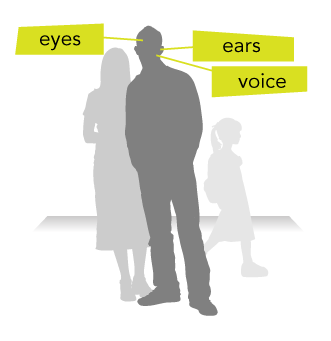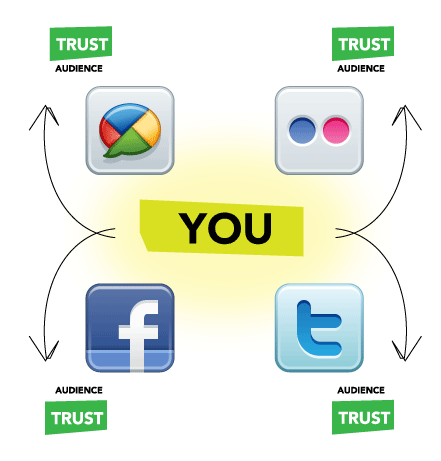Anatomically speaking: branding as a kit of parts.
A brand has pieces that make it up:
 Logos, colors, typography—the eyes of the operation. Usually the first and foremost ingredients. These inform the way people visually perceive the brand. Many people consider this most important role, but you must remember that not everyone can see a brand in the typical sense. Those with diminished senses or disabilities view a brand differently.
Logos, colors, typography—the eyes of the operation. Usually the first and foremost ingredients. These inform the way people visually perceive the brand. Many people consider this most important role, but you must remember that not everyone can see a brand in the typical sense. Those with diminished senses or disabilities view a brand differently.
Words, sound effects—the ears. Often the goals of the campaign will determine where these are used, so realize the context of your advertising and find out what kind of person your consumer is, to help you make logical business decisions that entice that very specific consumer you are trying to chase.
Voice, grammar style, tone—the voice. This is informed by other anatomies, but it is an important one nonetheless. You can easily change the way a brand is perceived simply by changing the tone or speaking style that it uses. A lot of times many small companies fail to grasp this important piece, and they go about it haphazardly. Other times companies will spend much time in crafting a voice that is synonymous with the crowd it seeks to attract. This is more prevalent in radio commercials than anywhere else. Think of the nuances in the countless fast-food commercials you might hear in the 3 minute span of a commercial break. You can go from a subtle, sweet womans voice to a rough-and-tumble construction worker to a socially-awkward braniac, all in a few minutes, all advertising very different (or seemingly so) things.
Strategy, market timing, target demographic research, evaluation studies, focus groups—the brain. This is where the strategic decisions are made. Without a targeted direction, a brand is floating in the ether, with little to no apparent meaning. If a brand is lacking in brains, it makes uninformed decisions that provide little or no value to itself, and can even be harmful.
Brand-able
A brand is only as good as the people who manage it. But a brand is sort of a person itself. While its propped up by money and people, a brand’s perception is very similar to the persona of an individual.
A brand can be anything. It can be mean, friendly, intriguing, smart, alluring, or all of the above. It can work in different countries or just one. It can act indifferent or it can help the needy.
A brand is really an extension of a person, overlayed onto a corporate blueprint. If you think of your brand as a person, it makes branding a lot easier to visualize and thus apply modifications.
The $1,000,000 BrandMan
If a companies budget is very high, we can think of that brand as being a wealthy person. A wealthy person has access to many opportunities and capabilities a poor person would not. Budgets are still a metric of importance for many big companies.
But what if a budget is big, and the brand is still not getting attention? Or it’s only getting bad attention? That can be thought of as a wealthy kid who has no personality, or perhaps is mean. Regardless of their social status, they may not get along with most people because of their attitude, or perhaps other factors.
A perfect example of this is Microsoft. No matter how hard they have tried to convince the public their product is not faulty, not gimmicky, or that the BSOD (blue screen of death) is not as big a deal as it sounds, Microsoft has operated under a tarnished reputation for quite some time.
And it has made belligerent mistake after mistake, whilst trying to throw money at public relations and advertising. They have never really buckled down and focused on fixing anything. Just like their product, they’ve undergone a sort of “half-assed” ideology which has informed the way they approach marketing as well.
Lots of brands have had to cope with bad press and some have even gone under as a result of it. Bad press can be terrible and irreversible to your company, and throwing money at the problem may just fan the fire.
Don't be a Microsoft
Don’t let your brand get mired down in that struggle of brand perception. Your brand is a model for your business success. Figure out what kind of person you want your brand to be.
No more Mr. Nice Guy
A person has to makes decisions which affect their outlook on life and also the way people perceive them. If you are constantly rude to people, you’ll quickly earn a reputation for being annoying, and likely the person people try to avoid.
Conversely, if you always appear nice and friendly, people will usually find you pleasant to be around. There may also be nay-sayers who consider you to be a “goodie-two-shoes.”
There are as many personalities as there are people. From the intellectual know-it-all to the brawny “meathead”, brands convey a certain persona that is remarkably comparable to a physical person.
It’s important to at least think of your brand in this way from time-to-time. If not as a full-time strategy, at least as a basic primer to understanding brand perception.
This outlook makes many strategic decisions made by marketing directors seem less superfluous and murky. Why does a brand or company do charitable work? Usually because they want to be perceived as “good samaritans.” This is a trait reserved for people, not corporations.
The concept of “brand trust” plays heavily into this viewpoint. As consumers increasingly face more confusing choices, they revert to basic instinctual motives to help drive their decision-making. Brands now recognize and increasingly spend money on simply earning the trust of an individual.
Social Media
Now that you understand the context of “brand trust”, you can easily see why social media has become such a tremendous boon for brand exposure and capability. Its explosive growth is fueled by brands who seek a new medium to target individuals.
 Of course these social media sites always seek capital to fuel this growth, so this new medium tends to evolve in the direction of monetary influence. This explains why social media sites have fervently sought to track and sell consumer data. This data represents a valuable asset to companies: the medium to influence and advertise, and the corresponding “big data” that helps zero in on the right market share.
Of course these social media sites always seek capital to fuel this growth, so this new medium tends to evolve in the direction of monetary influence. This explains why social media sites have fervently sought to track and sell consumer data. This data represents a valuable asset to companies: the medium to influence and advertise, and the corresponding “big data” that helps zero in on the right market share.
Most all major growth moves in the direction of money, simply because money is a means to survive. It is likely that the major players of social media will always move towards this trend until it no longer represents a viable medium.
The end of T.V.; the beginning of DNA
Once again, you can begin to understand other trends as a result of this “looking glass” of brand perception. Look at T.V. It was considered to be a tremendous game-changer for the world, and for quite some time it has dominated the globe as an advertising tool. Time, however, has overexposed us to this medium and it is reaching its mathematical limit. It has begun to slow down heavily, as media buyers are searching the horizon for new opportunities.
This will eventually be the case for social media, mark my words. It may not be for quite some time, or it might be next week, but it will happen once consumers become too entrenched by it.
If the social media world diminishes, it would certainly seem to spell the end for advertising resources. What’s next? Perhaps we’ll see genetics being fueled by marketing, and we will target consumers in a wholly new pervasive manner. How? Perhaps from their own DNA. Maybe we will develop genes that act as antagonists to our own mental thought centers. That’s a scary thought if ever there was one, but only time (and consumer-preference) will tell.
Brand evolution in the 21st century and beyond.
What will brands of the future look like? Will they take on a role of benevolence or malevolence? Based solely on chronological trends, most brands have undergone immense transformation towards what a lot of people will agree to be greedy or sometimes malevolent.
Generally speaking, there has always been a consistent view of marketing and corporate culture as being grossly negligent of individual needs and rooted in deception and manipulation.
This is not necessarily a permanent trend. In fact, I think it is likely that brands will move towards benevolence, because a need for teamwork will arise in a world of arising complexity. Brand fragmentation and distrust cannot be sustained if the world continues to multiply.
Consumer preference: brand reform
Consumers have increasingly had access to more choice and buying freedom. Where there used to be a few hundred brands, there are now hundreds of thousands.
You and I as consumers have so many options when we go shopping. Whether it’s food, fashion or fun, we can pick and choose from many companies.
This choice did not exist a hundred years ago. People of all colors and cultures can choose these brands equally. With the advent of increased technology, we can put the tools to create a company in the hands of an individual.
This democratization of data has been a boon for freedom. While it has made the marketplace confusing, it does give the common person access to all kinds of selection.
This selection has given consumers so much choice, they are very discerning about what they want. It is no longer a luxury to most developed countries—it’s simply the status quo. In conjunction with the depth and breadth of capabilities that are available to the commoner, it is great for brand reform. What once only a giant conglomerate could do in a few years, a joe six-pack can now do in his backyard.
Many people are cynical about advertising. Even as an advertiser, so am I. But I think the freedoms technology bring heralds a new world of innovation and selection, brought about by common folk. The constant fragmentation of data and the breakneck speed at which the world moves means only the leanest companies will survive. And guess what? The leanest companies are small ones that usually promote benevolence.